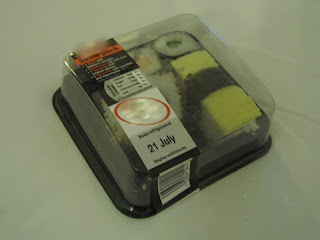A draft as I need to find the name of the cookery book - and some photos.
This is my version, which we ate at O's flat with T, alongside a slow roasted tomatoes and a watercress, pear and lime salad. The salad was better than the tart (perhaps because the tart travelled across London on a hot tube and then sat in the fridge at work all day). Pastry goes soggy, I forgot that. Next time make on the day (or without the cream cheese).
Roast fennel tart with lemon and Gorgonzola
For the tart
A square of short crust pastry, about 20cm diameter.
20g of organic butter
Three small to medium sized fennel bulbs
Rind and juice of half a lemon
A tablespoon of honey (optional)
100g quark or cream cheese
Two roasted cloves of garlic (from the tomatoes, below)
150g of Gorgonzola
A teaspoon of fennel seeds
Wash and slice the fennel. Chop off the very base and the green stalks at the top (but keep any of the wispy frond like leaves), and then cut into 4mm slices, try and keep the fennel together in each slice (so that it doesn't fall completely apart). Put the butter in a griddle pan and melt. Add the fennel and roast, initially on a high heat, but don't let the butter burn. Add the rind and juice of the lemon and the fennel seeds. Turn until the fennel is starting to go brown, then lower the heat and cover until it softens. I also add a little honey to make it caramelise, but that's because I'm putting honey with everything at the moment. When the fennel is golden brown and soft, take the dish off the heat.
Roll out the pastry (from the packet in my case) into a square onto the greased baking tray. If the corners bend up the sides slightly, this doesn't matter. I was busy and feeling lazy so bought the pastry from the supermarket, but it is worth making it if you have the time. Jamie Oliver has a recipe online for
sweet short-crust pastry that looks good.
Bake the pastry blind for 10 minutes.
Take out of the oven and allow to cool. Meanwhile, take the skins off two of the roast garlic cloves and mash with the cream cheese and a little salt and pepper. Spread over the pastry, leaving a couple of millimeters to the edge.
Set out the roasted fennel on top of the cream cheese, trying to keep the slices of fennel together where possible. Sprinkle small (1cm) cubes of Gorgonzola over the mixture, and also any little green tufts of fennel from the top of the bulbs. The dish can be set aside at this stage if you wish. Put back in the oven with the grill on until the cheese melts and begins to bubble a golden brown.
For the slow roast tomatoes
This is adapted from the Nigel Slater recipe I made the other day with goats cheese.
Six good quality, dark red, medium sized tomatoes, sliced in half
A third of a bulb of garlic, broken into cloves
Olive oil (just standard stuff - I used the oil from my jar of sun dried tomatoes)
Two sprigs of thyme (I used frozen this time)
Extra virgin olive oil (about 2-3 tablespoons)
Maldon salt and pepper to taste
Slice the tomatoes in half, and place on a baking tray sliced side up, the garlic scattered between them. Drizzle over the olive oil and place in the oven (about 200 degrees) initially at the top, and then after about 20 minutes take out of the oven, remove the garlic cloves and return the tray to the bottom shelf. Put the heat down a bit if they appear to be cooking too fast.
Take the cloves of garlic out of their skins and mash with a little olive oil.
The tomatoes are ready when they start to dehydrate and collapse slightly. They should look overcooked, but not burnt or dried out. Spread a little of the garlic mixture on each tomato, arrange on a plate, scatter with two sprigs of thyme and a generous amount of extra virgin olive oil, salt and pepper. Cool and serve.
For the watercress salad
A bunch of fresh watercress (I like organic, if you can get it)
A bag of lambs lettuce or pea-tops
Two soft conference pears
Rind and juice of a lime
Dash (half a teaspoon) of hazelnut or sesame oil (optional)
Four tablespoons of chopped, roasted hazelnuts
Extra virgin olive oil, Maldon salt and black pepper
Wash the watercress and lettuce and take the large stalks off the watercress. Core the pears and peel if you want to, but I quite like the mottled green skins against the white flesh. Chop into thin slices and place in a bowl with the rind and juice of the lime and the hazelnut/ sesame oil if you're using.
Conference pears (image courtesy of Glysiak wiki commons)
Dry roast the hazelnuts (e.g. fry without oil in a pan over a medium heat) until brown but not black. Pour out of pan and set aside (if you leave them in the pan they'll continue to cook and then burn, I've done this before with pine-nuts). Slice the hazelnuts in half once cool.
Add pear & mixture, hazelnuts, olive oil et al to the lettuce, toss together and serve immediately.





















































